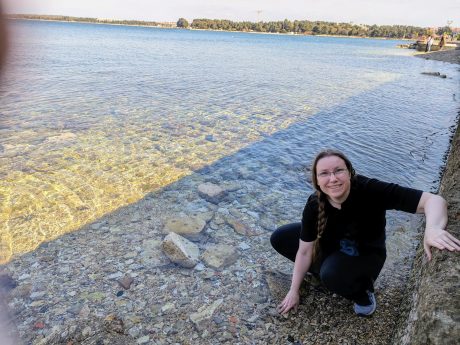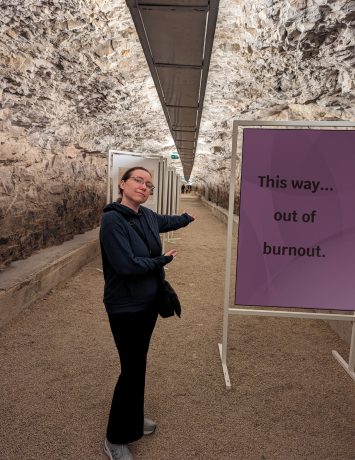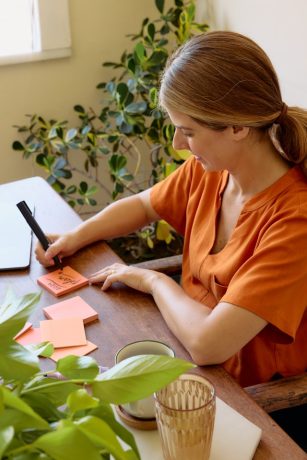Beyond Autistic Burnout
A practical system for sustainable recovery,
without quitting everything.
How to recover from Autistic burnout and break the cycle so you never have to go through it again.
Hey there,
I’ve been through autistic burnout too many times. (Though I called it other things at the time—depression, adrenal fatigue, laziness, “what the hell is wrong with me?!?”)
I was so tired. All the time. Tired of saying I was tired. Tired to the bones. I mean exhausted.
Is this familiar? Can you even remember the last time you felt fully rested?
But it’s not just the exhaustion. (As if that’s not enough.) Everything’s hard. Making food. Dragging yourself to work. Dealing with family. Leaving the house feels like climbing Mount Everest. Even getting the mail involves so many friggin’ steps.
I’m guessing you’ve already cut back so much in your life. But it’s never enough.

How do other people manage all. the. things.??
Sure, they say they’re stressed, but they’re doing more than you, yet you’re barely functioning??? It doesn’t make sense. It’s not fair. And there’s a niggling fear that it’s because there’s something fundamentally wrong with you.
Are you weak? Is this your fault? It doesn’t help that certain people (your boss, partner, parent, ex-therapist, the other moms) make little comments along those lines.
Because, let’s face it, your brain feels like it’s been scraped out and replaced with a thick fog. You keep forgetting basic things, like the names of common objects. You can’t manage the dishes and schedule appointments and find the kid’s shoes and get yourself food, and remember litter for the cat. I mean, who can keep track of all that???
Some days, just getting out of bed feels like an accomplishment.
And even one thing on your schedule means the whole day is shot. Or the whole week.
Everything is overwhelming.
You can take zero stress. Zero pressure. Every “little” thing is a BIG FRIGGIN’ DEAL.
Life shouldn’t be this hard.
This isn’t normal.

Not even for you. It hasn’t always been this bad. Things have been getting harder.
You can’t do things you used to be able to. You don’t even care about things you used to anymore. You spend a lot of time doing nothing. But you don’t feel any more rested. Everything sucks.
The thought of going back to work fills you with dread.
And – TMI time – showering, brushing teeth, keeping yourself clean and fed, is a slog of endlessly repeating nonsense that feels hard and pointless and, let’s face it, icky. Why does the human body need so much work??? Ugh.
And don’t get me started on socializing. “Just go out more,” they say. “It’ll be fun,” they say. But you get home wiped and need three days to recover, minimum. Or a week.
You can’t keep on like this. Something has to give. But you’ve tried the standard advice, even some weird shit, but it doesn’t help enough, or at all, or is actively counter-productive.
Is this a bit too familiar? Yeah, I get it. I’ve been there. Too many times. For far too long.
And I’ve gotten out.
I’ve structured my life in such a way that I’ve been burnout-free since 2015!
Really.
More on that soon.
The Dream
But first, a bit more about you.
You’re not asking for the Moon.
You don’t absolutely need a pile of money and a team of silent, robotic servants to magically appear and take care of all your needs forever, without any human interaction. (Although, hey, that would be wonderful, where do I sign up?)
But you do need solutions. For your real life. And that’s entirely reasonable.
It’s entirely reasonable, and possible, to build a life that feels good and is sustainable for your Autistic or AuDHD brain and nervous system.
To have reliable energy, think clearly, and be able to manage day to day life, generate a stable income, and take care of the responsibilities you choose to take on. To feel capable again.
It’s entirely reasonable, and possible, to feel more comfortable with yourself, with others, and build positive relationships that feel good.
To feel hope. To dream again. And maybe even have enough energy to make a positive impact on the world.
That’s not too much to ask.

In fact, that’s entirely reasonable. And possible. Even for your wonderfully Autistic or AuDHD self.
I'm working hard on not beating myself up about being "behind". Your positive messages about this are really helpful. And I'm actually finding the asynchronous setup is working really well for me. The course platform is great, really easy to use and navigate. Again, Thank you."

What you may have tried before
Have you tried meditation, medication, CBT, or years of therapy? What about exercise, epsom salt baths, getting out into nature, positive affirmations, or accepting your limitations?
Have you tried to get accommodations at work, or take time off?
Do you routinely make excuses to friends and family to get out of “fun activities” that are, in fact, a sensory nightmare?
Do you sleep as much as you can, isolate so you don’t have to deal with being perceived, and try to engage in special interests, but they don’t feel the same anymore?
I’m guessing you’ve also tried explaining it to people over and over, told them what you need, and they just don’t get it. Professional “experts” don’t get it. Some don’t even bother trying to listen.
Others just complain that “this isn’t who you used to be,” and expect you to snap out of it, to go back to “normal.”
Probably some of that has helped, sometimes, for a while, but it’s never enough, it doesn’t last, and it’s not sustainable.
And you would have tried more, but there’s no point wasting your little energy on stuff that’s clearly not going to work.
Are you ready to break the burnout cycle?
Learn the skills and techniques to get out of autistic burnout for good!
Why it’s so damn hard
Can I take a moment to acknowledge that this really is hard. So damn hard. And flippin’ unfair.
There. I said it. And it’s true.
But you’re NOT broken, defective, weak, flawed, lazy, or the only one struggling like this.

Those solutions were built by ableist neurotypicals, for ableist neurotypicals, and they’re trying to smush us back to functioning in an ableist neurotypical way.
Which, news flash, is precisely what got you into this mess. So doing more of that, harder, isn’t going to get you out of it.
No wonder you’re not motivated to follow their advice!
It’s all built on the same flawed premise that you can “behave” or medicate your way into being neurotypical. Not gonna happen.
Why those other solutions didn’t work
Ultimately, none of that stuff address the root of the issue.
Because it wasn’t built for your neurotype, your needs, your social history, how your brain and nervous system function, or your identity.
And let’s be honest. A lot of the standard advice essentially boils down to, “You should practice self-care so you can continue the charade longer.”
It’s just another way to squish your autistic peg into yet another neuronormative hellhole, and then blame you when it doesn’t work.
Deep breath.
Okay, to be fair, not all the advice out there is crap, but a lot of it is. And the rest either isn’t tailored for Autistics, or doesn’t do enough to fully get out of burnout and stay out.
Because nothing is going to really, ultimately, sustainably work, unless it addresses what got you into burnout in the first place.

Seventeen months on, I’m holding an active role in a community organization—something I didn’t think was possible. I’m feeling more capable and noticing that I’m gassing out and suffering less. This is exactly what I’d hoped for: real, sustainable improvement.“
What really causes autistic burnout
So what is really going on? What is the root of the issue?
Autistic burnout is the final straw. It’s the most obvious, physical sign of things that have been going on below the surface for a long time.
May I try to connect the dots for you?
Is any of this familiar?

You’ve probably been feeling stressed or over-taxed for a while, but it didn’t feel like there was anything that could give, any way to let up, anything else you could get out of doing.
So you kept pushing too hard, for too long.
Maybe you’ve been physically doing too much. But you don’t have to objectively have a lot on your plate (according to capitalist productivity standards) to still be over-stressed.
I’m talking about when you’re with other people, and you’re putting out a ton of energy to be “on,” to not say the wrong thing, to constantly monitor how they’re reacting to you. That takes a huge amount of energy and mental resources.
And you’re probably physically uncomfortable, fighting your senses to “deal with” things that other people don’t even notice, trying not to be completely overwhelmed, and that also takes a huge amount of energy.
And years and years of fending off the sensory world has resulted in either being ultra aware of absolutely everything, so the neighbors lawnmower feels like a piercing intrusion…or barely noticing your own body, so you don’t even know when you need to eat or drink or rest, so you’re constantly surprised when that stuff becomes an emergency.
And years of misunderstandings and being misjudged and rejected in confusing circumstances have led to a hyper-awareness of any potential criticism, or pressure, or rejection, or demands, to the point that even being perceived by others feels like a demand upon you, and the pressure builds up until you can’t stand it anymore.
And you’ve been trained to blame yourself for everything. After all, you’re the constant in all these situations, and you’re the only one complaining, or the target of complaints, all the time. And the negative self-talk, and self-judgment, and self-blame, and shame, and anxiety, and rumination, is intense.
And all this has been adding up, and festering under the surface, and building on each other, and it’s overwhelming.
And you’ve been pushing, and ignoring it, and telling yourself it’s “fine,” and that it’s not important enough to invest in a solution, and you’re not even sure if there is one, so you’ve been trying to adapt to what everyone expects of you, and just do better.
Until you couldn’t anymore. Until burnout forced you to stop.
How much of this have you been experiencing?
i like this whole set up: the well thought out and organized workshops.
you understand "how" to teach people and break it down so it can get integrated.
appreciating your personal stories. they give me a visual that "sticks" for me.
seriously, your nuggets of wisdom and your story itself, and basically YOU putting yourself out there has shifted me and lifted me enough to get up and on my way. i feel lucky to have found you.
okay. this sounds like i'm blowing smoke up your ass...but you know i'm sincere. 😀
Thank you for all that you do!"
What to do about it
If you boil down all of that underlying buildup, there are essentially five key, interrelated areas that cause autistic burnout.
Whether you work with me or not, these are the five areas that need to be addressed to really get out of autistic burnout:
- Not feeling able, or allowed, to adjust things to your sensory needs. Or not having a clue how to do that.
- Not having a useful sense of what your body physically needs at any given moment, to know what you want to adjust (beyond the obvious), and to keep your body working well and feeling good.
- Not feeling at ease with other people, so it takes a ton of energy to deal with people, so you avoid it when you don’t have to, so you’re frustrated and lonely.
- Getting on your own case about everything you think you should be able to deal with, or do better, or more, or how badly you’re functioning, or that’s going wrong. Or alternately, raging at the world for discriminating against us (this is also a huge energy drain, and a block to making some things better, when you could).
- When you do have any energy, using it up on things that don’t really help you get where you want in life. Not being able to tell how much is too much until it’s too late, and when you do get to rest, it’s not all that restorative.
Does this resonate with your experience?
Two questions
If so, I’m curious how it feels for someone to finally lay it all out there in direct language.
Deep breath.
Before I share how I address these things, to help people out of burnout, may I check in with you about two things:
- Is the process of addressing these things, to recover from autistic burnout and make a new life for yourself, a journey you are committed to going on?
(This is committing to yourself; not me or anyone else.) - Is now the time for you to embark on this journey?

What will work
In my autistic burnout recovery system, I specifically address each of these five areas, with both unlearning and learning components.
And I’ve tried to keep it super practical and realistic.

Because I know you can’t quit your job, your family, and all your responsibilities (as appealing as that may be sometimes).
And yet, your impulse to cut back on things has been spot on.
But it matters what you’re cutting back on.
Getting out of social events, while feeling guilty at home, and stressing over what they’re thinking about you, and when they’ll be back, isn’t as restorative as one would like it to be.
Cutting back on work hours, without changing the actual conditions of your work, and your relationship to work, doesn’t make as much of a difference as one would hope.
On the other hand, decades of trying to conform to neurotypical expectations have left their mark, and cutting back on those will help tremendously.
The way I see it, sustainable recovery is just as much about unlearning ableist crap as it is about learning skills for a healthy Autistic life.
I propose a holistic approach to addressing the five areas that I have found are essential for sustained burnout recovery.
Designed specifically for the challenges that we face as Autistics and AuDHDers, especially when you’ve struggled for decades not knowing this key part of who you are.

The five key, interrelated solutions are:
- Accommodating your authentic self. This includes figuring out what’s you and what’s the mask. What you really need and want. And masking/camouflaging/shielding less, to the extent that it is safe, when it is available to you.
- Figuring out and accommodating your sensory needs.
- Increasing useful internal awareness, so you can know what you need in real time. And using this to make more authentic decisions for your own good.
- Noticing and dissolving internalized ableism, and other inappropriate expectations, and the effects of negative messaging from others, including negative self-talk, guilt, and shame.
- Getting better at energy management, to use your energy intentionally for only what is worth it to you (like working towards a better life).
If you were able to make tangible improvements in these specific areas, do you realistically think it would reduce your burnout? And improve your life in general?
And if you worked on improving these things, do you think you would become a better version of yourself?
If you had access to a guide that could illuminate how to do this, would you use it?
Because of this, I took the courage to let my Dad know that I wouldn't be able to make it to Christmas dinner this year...By doing this, I feel more courageous to make other similar choices and enjoy this great feeling of freedom, authenticity and agency....I have much to look forward to!!!
Thank you for helping me create a better life."
Also the layout, the colouring, how easy it is to use/learn, the progress percent so you know if you're up to date.
I am so grateful to have found your website and to able to do the course 🙂 thank you!"
Why I think my system can help
Remember when I mentioned that I’ve been burnout-free since 2015? It’s true.
By the way, I’m Heather, I’m Autistic and ADHD, and I know this burnout stuff so intimately because I’ve been through two major, life-halting burnouts, and a dozen smaller ones throughout my life, and searched for years to find anything that would provide more than minor, temporary relief.

I tried just about everything to get my life back. I struggled for years to find anything that actually helped, and threw away what didn’t.
After my last major, life-halting burnout, in 2015, I reached the point where enough was enough. I knew in my gut that I had to entirely overhaul my life or I would die. I went whole hog, making huge changes all at once, but I don’t think that’s necessary.
In fact, it was a few, small, key changes, that built up over time, that made the biggest difference.
But I didn’t get my life back.
By which I mean, I didn’t go back to the damaging, ableist lifestyle that had hurt me over and over.
Instead, I created a Second Chance Life that actually feels good.
It took years of trial and error, experimentation, and refining, to sort out what actually worked from what claimed it would, but didn’t, or what was more hope than real relief, and what was just a placebo effect that soon faded.
And then to get clear on why those things worked so I could reproduce it, and to test that it wasn’t just me, that this works for many other Autistics as well.


Since 2020, I’ve helped over three hundred other Autistics customize their own versions of this Journey, and make significant improvements in their burnout recovery.
(Which also made their lives fit them better. And they ended up liking their lives, and themselves, better.)
In the process, my pattern-loving brain has been working at systematizing what has consistently been helpful for all of us, in order to make that easily available to more people, with less effort.
This course is the result!
The testimonials on this page are reports from real people who have taken this course, sharing that this system has helped them make significant improvements in their autistic burnout recovery.
The Recovery System
My autistic burnout recovery system starts with:
- How to unlearn the damaging, untrue messages from the Capitalist, Colonized, Ableist, Neurotypical, and Traumatized standards (the CAN’T world) that do not serve you. Without accidentally gaslighting yourself!
- Then we’ll get into the deep stuff just enough (this isn’t therapy) to find your two or three key personal things, that when they are freed up, will make a big difference.
- Then it’s more possible to learn healthy skills that work for you, so you can use your small bits of energy in building a Positive Life for your Autism and Neurodivergence (your PLAN life).
- Then the super practical strategies will actually work, and I’ll offer options for day-to-day relief in each of the five key areas of burnout recovery. Including what to cut back on that will really make a difference. And what to do on the bad days. (Let’s be realistic. They’re still gonna happen.)
- Then something will come up that you’ll notice needs some unlearning, and you’ll go through the cycle again.
It’s a spiral. Which you’ll go around and around, each time unlearning more CAN’T world crap, and learning how to build your PLAN life, bit by bit.

This all comes wrapped up in a neurodivergent-friendly, trauma-sensitive experience.
Does this seem like it would make a difference for you?
Is this a good fit for you?
Unlearn the patterns and pressures that got you into autistic burnout!
I really like your learning/unlearning recovery framework - it's something I've been noodling on for about a year and it really resonated with me. (I was raised in a cult so I've thought of it more as un-brainwashing that just extends further than I would have thought.)"
Program Breakdown
Okay, that all seems great, but I can practically hear you asking, “But how is this actually going to work? What will I have to do?”
Fair question. Here’s an overview of what the course entails:
Module 1 - Setting up the system
Introduction to the system of burnout recovery. Explore why life/everything has been so hard (psst, it’s not your fault, it’s stacked against you), and the three frustrating catch-22s that makes healing harder. Plus reasons to hope that there are ways around the roadblocks.
- Introduction to the 5 areas of burnout recovery. Why these areas matter. How they interconnect and influence each other.
- What recovery looks like and an overview of how to get there.
- The #1 mindset shift that will make the biggest difference.
- Tool #1—how to get some distance from anxious and ruminating thoughts.
- What kinds of energy you want, and what kinds you don’t. (It matters.)
- Get access to your burnout recovery dashboard.
Module 2 - Dissolving internalized ableism and other negative messaging
Practice several techniques to notice and dissolve internalized ableism and other negative messaging, without accidentally gaslighting yourself.
- What internalized ableism is, how it’s been affecting you, and how to recognize ableism in everyday life.
- How to get better at emotions (even when you’re alexithymic), breaking down what they are, why they can be so tough to navigate, and how to get better at recognizing what you’re actually feeling.
- Tool #2—how to go deep without re-traumatizing yourself.
- PLANning the life you’re working towards.
Module 3 - Seeking authenticity
Exploring authenticity, masking/camouflaging less, to the extent that it is safe, when it is available to you, and what it means to show up as your true self. Figuring out what’s you and what’s the mask. Exploring your own wants and needs.
- The benefits and challenges of facing old wounds, insights on why we mask, and how to heal from past experiences.
- How to navigate when it’s safe to be authentic.
- Accepting that we won’t be accepted by everyone — and that’s okay.
- Tool #3—how to handle fears and worries.
- Dealing with “changeback attacks” from others.
- How to reinforce positive experiences and progress.
Module 4 - Increasing useful internal awareness
Gently and gradually building useful (non-overwhelming) and real-time awareness of what you need and want, and what is getting in the way, and how the inner and outer world affect you, so you can do something about it.
- How society trains us to normalize discomfort so we don’t really know what we need.
- The opposite issue: if you feel things too much.
- What being selfish really means—and what it doesn’t—especially when your needs conflict with other people’s.
- Tool #4—how to tell what you really need.
- How to use physical sensations and emotions in a helpful way.
- Practical ways to feel good daily.
Module 5 - Building a sensory-friendly life
Get better acquainted with what you have already done to accommodate your sensory needs over the years, and giving yourself permission to do that more intentionally, and to a greater degree. Exploring new ideas and options.
- Hard evidence that there’s nothing “wrong with you” for reacting to loud noises or other sensory stuff that other people don’t.
- Tool #5—another method for unlearning.
- How the words we use can either help or block progress, with options for everyday situations.
- Explore how our sensory experiences shift over time, and ways to support those changes to make life smoother.
- Using sensory integration techniques.
- Multiple sensory regulation options.
- How to create a personal sensory plan.
Module 6 - Energy management
Everything we’ve been doing so far will be freeing up a bit more energy, and now we’ll practice how to tell before you overdo it, so you can keep building and storing energy for when you need it.
- Seeing a lack of energy as a red flag.
- Breaking down the whole process of unlearning in a way you can do yourself.
- Unlearning the guilt of resting.
- Tool #6—exploring grief; specifically the kind you may not realize you’re carrying around.
- The five major areas of grief, with examples.
- Some simple ways to start working through grief.
- How to get curious and investigate when something is bothering you.
- What to do when you hit that point where your energy just disappears.
- How to stop before wearing yourself out by switching from output to input mindset.
- Why it’s crucial to match short and long term solutions for sustainable problem solving and a sustainable life.
In each area/month, we’ll explore:
- The double-bind, and the way out.
- The purpose/goal/endgame/what’s possible.
- Things to be careful of (common mistakes, common trauma triggers, this can be especially hard when…).
- The key question that makes this sooo much easier.
- Shedding ableist-NT baggage in this area.
- Dealing with painful and anxious thoughts in this area.
- What you can do in the short-term and long-term.

Is this what you’ve been looking for?
(Even if you didn’t know it?)
i can tell you truly care, heather. you are not sales-y. just human and wanting others to not suffer needlessly. i'm so grateful you took your heart and soul and dumped it into every detail of this course. it has NOT gone unnoticed! in fact, i feel it.
not many people understand "how" to show people how to actually pull out of something as life sucking and life-stopping as burnout. you not only speak on it, but speak it in such a clear manner. i'm getting it! you were my training wheels and now i can learn to ride the "after burnout" bike without the training wheels. forever grateful to you."
It adds up
Every time you shed a bit more ableist-NT baggage (from the CAN’T world), you’ll get a bit of your energy back, and can transfer that to building your PLAN world (a positive life for your autism and neurodivergence).
Throughout this course, you’ll gradually delve into understanding your own needs, hangups, and the habits that no longer serve you.
You’ll deconstruct negative messaging, and get a glimpse of what is possible, with gentle but poignant practices aimed at cultivating radical self-acceptance and releasing untrue self-judgments.
Over time, your personal insights and these foundational skills will create a ripple effect in how you deal with other areas of your life.
This is how small positive impacts begin to change your entire life for the better.
And don’t worry, you’ll have support throughout the process.

Fast forward. I just finished a normal 9-to-5 work day, and I'm about to bake oatmeal cookies. I have a game night planned with friends tomorrow. I'm not out of burnout. But I'm able to recognize what will nourish me, what I can't escape (like work), and most importantly, that it isn't a straight line to recovery. Ups and downs are part of it.
I was so angry during my years of autistic burnout, and I didn't even know what was really happening. So learning about myself has been essential, as well as all our work on unpacking traumas, and crafting tools, and really just being kind to myself and learning and growing, and having someone to help me.
TLDR Heather is the best 🧡"
What’s Included
I offered this live for the first time in 2024, and recorded everything.
What you’re getting is everything except the live interaction. All the recorded sessions, the handouts, the worksheets, the additional resources, and more.
This was my first time offering my autistic burnout recovery system as a “course,” and I’ll be honest, the format was a test. But the strategies and system were not.
I’ve helped over three hundred Autistic and AuDHD adults (and a few teens) to make progress in their burnout recovery, and this was my way to take the core of what I do and offer it to you on a silver platter, for much easier and faster results than I got (as in, not spending years of trial-and-error, having no idea if anything would ever work).
So…

…how’d it go?
Fabulously.
I’ve gotten amazingly positive feedback, so much that it even surprised me. The testimonials throughout this page are from those first participants, who found it genuinely life changing.
Did it fix all the problems in their lives? No, of course not.
Did it make burnout disappear completely overnight? Nope, that’s unrealistic, too.
But did it make a real difference? Yes.
And is it still having an ongoing positive effect? Are they still using it? Yes, and yes.
(And right now I’m in the process of making an ongoing support program to continue the positive engagement in small, manageable doses, long-term.)
You’ll get:
- Full access to all 6 modules.
- (This was originally delivered over 6 months.)
- All 6 workshops (5-6 hours each), for a deep dive into that topic’s focus area.
- Each module focuses on one of the five areas of burnout recovery, plus one (the first) to introduce you to the system and the tools we’ll be using.
- Human-edited transcripts of everything (no funky AI mistakes).
- Audio-only versions for easy listening.
- Slides, handouts, worksheets.
- An additional resource guide for each module with recommended books, articles, videos, and citations to research, etc. for a deeper dive into specific topics covered, if desired.
- 6 group coaching calls.
- Recordings and transcripts let you “eavesdrop” (with permission) on real Autistics getting coached, putting the system into action.
- Watching others get coached can offer clarity and insights into your own situation, without having to be visible.
- Appx. 90 Minutes each.
PLUS:
- Brand new reflection prompts, thought exercises, worksheets, checklists, and spreadsheets that even my private clients haven’t gotten yet, to help you make progress faster and easier.
- Your autistic burnout recovery dashboard—a customizable:
- toolkit for the bad days.
- reminder of things that work for you (because memory=??).
- helpful hints to self.
- overview of how much you have going for you! (Sometimes it’s easy to loose sight of that.)
- Coloring pages with quotes from the course, for your doodling pleasure while watching/listening to the recordings.
- Online community space for asynchronous discussion with others in the course, if desired.
- Built-in feedback opportunities to ask for what you need.
Does this seem like it would be a fit for you?
As you described your framework, I realized this was exactly why. I LIVE in the deep stuff, the underground unseen stuff so few people are willing to address (probably most of us autists do). But you've addressed it, and have built a model that incorporates constantly addressing it, and I now see that my lack of motivation for learning and working alone was less about a personal failing, and more about others' inability to address the real structural problems of our culture.
I feel like this is a foundational insight for me, and widely applicable, moving forward."
How much is it?
My private clients, who have made significant progress in their burnout recovery, have typically spent anywhere between (cough, cough) $4,000 and $6,000 with me for individualized, personalized help, over two to three years on average. And they’ve gotten great results they love!
That’s a lot of time and money.
But to feel capable and comfortable in their own skin, to be able to hold down a job and earn back many times that amount, and have a future they look forward to again, it’s been sooo worth it to them (which they’ve told me over and over!).
Don’t worry, I’m not going to ask you for that much. For a group program, and now as a recorded version, I would naturally charge less, but could still reasonably price this at $1,200 for the amount of info and value I’m packing into this program. And I probably will, when I do it live again (probably in 2026).
But since this is a first run of this format, and recorded, and because I’m hoping for your feedback on what works best and what is not as useful to you, I’m offering this for a special first-time price.

Anticipated time investment to get results: 1-3 hours per week, to watch one session recording and do a worksheet or some personal reflection/journaling, as desired.
Plus any additional self-generated ideas to integrate this stuff into your life.
Total value: $4,000+
Likely future price of this course: $1,200
Your contribution is only: $500
Payment plan available.
It's not an exaggeration to say that I rarely (if ever) felt so understood, even though the course catered to all of us in the group. There were lots of nuggets or knowledge that made lots of sense when Heather told us, but which I seemed to have buried somewhere not accessible to me.
The notion of 'dirty pain' was particularly useful and the course built up a wealth of knowledge that then worked really well with the strategies that were presented to us.
I can't say that I'm finished with it but, as Heather said, I don't need to beat myself up about how quickly I do it. That in and of itself is a development for me.
I have been lucky to have a good therapist that understands my specific struggles as an autistic person decently, but this was even better than that and I'd love it if more people could benefit from Heather's help.
Thanks."
Are you ready?
Get instant access and start getting out of burnout now.
During the first workshop day I was able to unlearn the idea that there's something wrong with me for not enjoying popular events. That really landed for me in real time. For years I went to loud concerts and tried to like it because my friends at the time did, but I almost never had a good time. That was something I was blaming myself for and didn't even know it.
Thank you for this course. It's a really impressive undertaking, and it makes me hopeful that one day I'll be able to take on big things too!"

Guarantee
My goal is for this to help you improve your burnout.
It’ll take time and input on your part to work through the things that need to be worked through, and to make at least a few little changes to start with, leading to more over time, but I truly believe that this will help.
But if it doesn’t, I don’t want you to be out the money.
So here’s my promise to you:
If you give this system a fair try, implement what is presented, deeply question your old programming, do the deep work, try the practical tools, and don’t notice any improvement in your burnout within six months of enrolling in the course, let me know and I will refund your money in full.
Basically, if you sign up and don’t use the course, that’s on you. But if you give it a fair shot and it doesn’t actually help you, that’s on me. Is that fair?
One more reality check.
To make the life-altering changes that will really be needed for full, sustainable recovery, it’s going to take longer than six months.
But I expect that you’ll be able to tell within six months whether you’re on the right track, and feel tangible improvements.
And if you continue using this system
to undo the effects of capitalist, colonized, ableist, neurotypical, and traumatized standards (CAN’T culture), and continue transferring that energy into building a positive life for your autism and neurodivergence (PLAN),
then you, too, will eventually be able to say you are burnout-free!

Is this what you've been looking for?
Learn the skills and techniques to get out of autistic burnout for good!

This may be a good fit for you if:
- If you’re done with how things have been.
- If you are at the point where trying something new is the only viable option.
- If making changes is less scary than spending another year, five years, or more, as things are.
- If you’re ready to put the small amount of time and energy you have into recovery.
- If you want a trauma-sensitive space and facilitator.
- If you self-identify as Autistic or AuDHD, or are comfortable being around us.
- If you’re willing to challenge the systems and assumptions that we’ve been trained to buy into all of our lives.
- If you’re open to exploring emotions and physical sensations that you may not have before, or in new ways, with support, a little bit at a time, and with a perspective and healthy skills that actually work for our Autistic neurology.
- If you love the truth, and want to learn how to align your life with your inner knowing of what is right for you.
- And if, for you, this isn’t just about getting more energy; it’s part of creating your autism- and neurodivergent-positive life.
Your recorded material, your coloring pages, and your low pressure approach have made this course all the more accessible to someone like me.
I am grateful for the way you set this course up to offer resources to a wide range of needs.
As far as the content, you have put together some stuff that makes the path out of burnout much clearer! I always feel understood and encouraged with your videos."
This will be a poor fit for you if:
- If you’re in the deep, dark depths of burnout, where absolutely nothing feels doable, no matter how good it seems.
- This also might not be for you if you’re absolutely not able to deal with even a little bit of body stuff yet. Some trauma healing might be more appropriate first.
- If you’re in an emergency situation and need major improvements in your life in order to be physically safe or survive, this isn’t the right fit right now. This program will take longer than you can afford to get the kind of results you need. Your best bet now is likely a more radical form of short-term help. Maybe come back to this when things are a bit more settled.
- If you fundamentally disagree with my philosophy as presented above, you’re not going to have a good experience.
- If you absolutely need the pressure of live meetings to get you to engage with the material, it might be better to wait for the next live cohort, or to take one of my other live courses. (I offer them from time to time. Sign up for my newsletter for announcements.)
- I’m pretty sensitive to PDA, but if your demand avoidance is so intense that anything you even slightly disagree with triggers a strong backlash reaction, and such intense criticism that you zero in on that and can’t take in anything else, this probably won’t be a good fit at this time.
- And, this might seem like a little thing, but this also may not be for you if you’re triggered by sentences beginning with conjunctions (oh, the horror) or ending with prepositions (hide the children!). I reject strict adherence to classical Latin grammar rules in modern English.

FAQs
Practical Details
Nope.
Since this is now an on-demand, recorded course, you get to do it all on your own via the recordings and transcripts and the materials online.
The materials were designed from the outset to provide a ton of value this way, knowing many Autistics would not want to attend live.
Both this course and my coaching are very much rooted in my philosophy, and my particular style. So you’ll get some of the same types of things either way.
The biggest difference is that coaching is more personalized, helping you work through your particular things, at your pace, according to your priorities.
The course is more systematized to teach the “how to” work through things, in an order that makes sense to me from having worked with over three hundred Autistics on their burnout. However, you have to do a lot of the actual working through things more on your own.
Another big difference is the cost. When you stick with coaching, it can add up to a lot more than this course.
My clients who have made the most progress on their burnout recovery have stuck with it for 1-3 years and often spent $2,000 to $6,000 with me. Whereas the course is currently only $500. (That’s less than 4 coaching sessions .)
So, which should you choose?
That’ll depend on which is a better fit for you at this time.
By the way, it doesn’t have to be either-or. They can be great complements to each other.
At some points in the course, you may want help applying the concepts to your personal situation, or processing some personal insight, or figuring out your best next steps.
You’re welcome to book a one-off coaching session at any time.
The whole premise of how I’ve set this up expects that you won’t be able to quit significant parts of your life.
So I’m not going to tell you to take time off, or get a babysitter, or just get a new job and expect everything will be fine. It doesn’t work like that.
I find that a major source of energy drain is the internal conflict between the societal messaging we have been trained to believe and the reality of our lives. And when you reduce that conflict, chunks of energy get freed up that you can then use to make your life better in very practical ways.
Often in little ways, but they add up.
I totally respect that. No doubt you’ve got a lot on your plate, or it feels like a lot (even if you objectively don’t have a lot going on). That’s how burnout is. I’m also wondering if that’s likely to change without you doing something to make it change?
Part of the point of this program is learning how to get rid of things in your life that are taking up your time and energy, that don’t need to be. So although this program will take some time, it’s also intended to give you back more time.
And isn’t this when you would like the extra support? When you’re busy?
I’m not sure if this applies to you. I totally respect your right to make the decision about whether this is the right time for you. These are just a few of my thoughts.
This is now an on-demand, self-paced course. So it starts anytime you are ready.
This is the recorded version of the last time I presented this live (in 2024).
This gives you the freedom to:
• Follow along at your own pace.
• Rewind and re-watch as much as needed.
• Pause to take notes.
• Engage on your own schedule, as your energy allows.
• Not feel guilty about missing live meetings.
• Not need to take it all in at once, avoiding overwhelm.
• Reduce demand avoidance of learning on someone else’s schedule.
• Come back months later for a refresher.
You will have access for at least a full year (and longer if I renew my subscription to the course platform, which is likely).
I don’t want to promise “lifetime access.” (Whose lifetime, yours or mine? Or the lifetime of the website? All of which could be misleading.) Which is why I’m intentionally cautious about promising too much, but it is my intention to keep this available for the foreseeable future.
Quite a lot.
There are a variety of accommodations built into the course for various learning styles:
- Human-edited transcripts (no funky AI typos) of every video.
- Transcripts include the slides so you don’t have to jump back-and-forth between files.
- Audio only files if you prefer to just listen.
- Summaries of each module to reduce note taking and to find topics easier.
- Table of contents built into each video to easily jump to topics of interest.
- The video player remembers where you leave off so you don’t have to find your spot.
- Handouts for easy reference of important concepts.
- The course website is WCAG compliant.
This is an inclusive, trauma-sensitive,* and BS-free zone.
ALL are welcome, including cis, trans, nonbinary, a-gender, gender expansive, and other LGBTQIA+ humans.
The language used throughout the course is intentionally gender inclusive.
*The presenter is trauma-informed and trauma-sensitive, but you are the best judge of what you can handle at the moment. Please take care of yourself.
Money Stuff
Yep. There’s a 6-month payment plan. And if you need an extended payment plan, email me and we’ll work something out.
Here’s a sample script to make emailing easier:
Hi Heather,
I’m ready to take your burnout course, but it would really help to break the payment into smaller chunks. I can pay $X USD per month until it’s paid off. Will that work for you?
Thanks in advance,
Name
I get that.
Quick story. (I promise there’s a point.)
I got an unexpected bill in the mail recently for a large medical expense that I thought my insurance had covered three years ago! Has something like that ever happened to you?
I hate it so much when some unexpected expense comes up and suddenly you need to shell out cash to someone that you don’t even care about, for something that you don’t want.
But the thing is, every time that’s happened, I’ve always managed to come up with that money.
It sucked, and I hated it, but I did it. And that was to pay for something that I didn’t even want, to some bloodsucking corporation I hate!
It was hard for me to start spending my limited money on myself. But when I was in my “change-everything-in-my-life-because-now-I-know-I’m-autistic-and-I-want-a-better-future” phase, I started thinking about the person I wanted to be, and imagining her, and it started feeling more possible.
And there was a part of me that knew, in my core, that it was only going to be possible if I started taking care of my future self in advance, so that she could come into being.
And that meant spending money on myself the way that I had been spending money on other people (and faceless corporate entities). And being just as resourceful in figuring out how to afford the things that I needed, that I had been when it came to paying for the bills that I hated.
I know it’s not as easy as just thinking about it differently, but thinking about it differently is what made it start becoming possible. And sometimes I just needed permission to spend money on myself.
Sometimes I genuinely have that permission, and I still don’t have the money. So if you need an extended payment plan, email me. We can work something out to make it possible for you.
The short answer is yes, with caveats.
I know there are times when there simply isn’t money, and it’s not about priorities or money mindset or scarcity mentality or conflicting pressures or anything. There just. isn’t. money.
If you’re ready for this and it’s just about funds, I will work with you to make sure you can get in.
Here are a few options.
- If you could manage paying but need more time, let me know how long you need and we can set up a custom payment plan for however many months.
- If you have a little energy to do a trade, and have skills I need, that could be a win-win.
- There is a small scholarship fund for partial scholarships, which several people in the course have contributed to (I get the warm fuzzies that some in our community who can are willing to support others who need it) and I am matching that dollar for dollar, plus extra. Most of that has already been allocated, but let me know if you want in and I’ll do what I can.
- If you know other people who might be interested in the course, or have a social media presence in a related area (that Autistics and NDs who might be in burnout follow), and would be open to helping me spread the word, that might be another win-win. I have an affiliate program, and you can get a discount on the course (or cash) for everyone who signs up through your link. Email me to get set up.
I hope some combination of these options will make it possible for you to take the course, and be a win for both of us.
If you give this system a fair try, implement what is presented, deeply question your old programming, do the deep work, try the practical tools, and don’t notice any improvement in your burnout within six months of enrolling in the course, let me know and I will refund your money in full.
Basically, if you sign up and don’t use the course, that’s on you. But if you give it a fair shot and it doesn’t actually help you, that’s on me. Is that fair?
Readiness
I want to be entirely honest and realistic with you. Is this going to get you completely free of burnout in six months? Nope. But it doesn’t need to. And here’s what I mean by that.
It took a long time for you to get to where you are now, and it’s going to take a while to get out of it. Not as long as it took to get into it, but it’s not going to be a quick fix. You already knew this. This isn’t new information.
So the question becomes, is this something that you believe will get you closer to that goal? Will this get you in the right direction? Will this give you the skills and resources that you can continue to use long term?
I believe it will. But what really matters is whether you believe it will.
Because there’s only three other options:
- Either this is going to move you in the opposite direction, further into burnout, which it just flatly isn’t.
- Or you figure out something else. That’s totally up to you. Do you have other ideas? I’m sure there are other things that will help. I’m not claiming to have all the answers, or that this will be everything you’ll ever need.
- Or you do nothing. Which you know how that turns out. More of what you’ve got.
But I think that this will considerably shorten the amount of time and effort, and trial and error, that it takes for you to get out of burnout and start building that better life. Your Second Chance life. What do you think?
The core of the system is about making a genuinely autism-positive life for yourself, which, when you do it, results in getting out of burnout and staying out.
If the descriptions throughout this page, and this vision of a better future resonate with you, and you want to learn how to make that vision realistic in your life, that’s what this does. It’s “the how” to do that, not just the philosophical level “that makes intellectual sense.”
So if you’re not really in burnout anymore, and want to stay out, you’ll have more capacity to implement the concepts and to make the changes needed to transform your life in a way that ensures you won’t ever go through it again.
Can I share something with you that might be a little hard to hear?
If you’re not up for that right now, go ahead and skip this answer.
When we’ve been deeply hurt by people, programs, systems, governments, employers, anyone—there’s the hurt that they do to us directly. That genuinely, absolutely is awful. It sucks. And then there’s the hurt that happens indirectly. Later on. When we lose trust.
And sometimes we try so hard to protect ourselves from getting hurt again, that we hold back from doing things, or trying things, or trusting people that could genuinely be really great for us.
Because so much of our energy and focus is on not getting hurt, that we end up hurting more by missing out on things that could be wonderful, and staying in that hurt place. I’m speaking from hard-won experience here. Does this resonate with you?
I’m not going to try and persuade you that mine is different and that I’m the person to trust. I trust you to decide for yourself.
I put out so much information for free (videos, workshops, articles) so that you can get a good taste of my point of view, my style, how I approach things, and use that to decide whether this program is the thing to take that chance on.
And I don’t know what the right answer is for you.
Ironically, this is possible when you’re in what I call the deep depths of burnout. Nothing feels doable. No help feels helpful. And unfortunately, I haven’t yet hacked what kind of help is useful in this stage.
I genuinely think it takes a lot of rest at this point to be able to get to a point where you can start doing things again that can make it better.
When you’re in those deep depths, if this doesn’t feel manageable, it will probably be a waste of your money at this point. Unless you’re just buying it to have access to it later.
But bear in mind that my guarantee probably won’t apply to you. The guarantee hinges on you participating by trying things and doing stuff. If my system doesn’t work for you, I’ll give you your money back. But if you haven’t even tried it, that’s not about my system not working.
I don’t mean to be harsh, and if it comes off that way, I apologize. I just want you to make a reasonable decision about whether this is going to be worth it to you at this moment.
I genuinely want you to have a good experience with this course, and it not end up as one more thing that didn’t work. Just because the timing was poor.
But the timing might be better at some point down the road. It’ll be here when you’re ready.
This is a reasonable question, and the kind of thing that I ask myself when I’m thinking about taking an online course.
I designed Beyond Autistic Burnout specifically for people who are in burnout, knowing what that’s like, and what I was capable of (and not capable of) during my burnouts. I drew upon those memories heavily to try structure it to avoid the things that usually tripped me up or were unhelpful: a lot of the common neurotypical advice and ways of approaching burnout and depression and anxiety and lack of motivation, etc. were either unhelpful or I actively hated, so you’re not going to find me recommending things like: go out for a walk, socialize more, or take three deep breaths. Bah!
A lot of what’s in the course is about making mental shifts, unlearning patterns of thought and expectations that are common and deeply embedded in our society, but that are untrue and unhelpful and counterproductive. It doesn’t take doing anything, at least at first, but when those old patterns of thought start to lose their power, it can lead to genuine internal motivation to want todo something about it.
I do offer some practical strategies, sprinkled here and there, but they still do not tell you specifically what to do, but instead are frameworks, or types of strategies, or a range of ideas and options, because we are all so different that every individual can personalize it by and for you.
A number of the people in the course have made comments that the way I have set it up has finally explained why they have not been engaged with most online courses, and they got much more out of this course than any others.
For example:
“What a mindset-altering insight I’ve already had. My fear about asynchronous participation is very much based on past experiences with similar courses. I could not maintain motivation on my own the vast majority of the time. As you described your framework, I realized this was exactly why. I LIVE in the deep stuff, the underground unseen stuff so few people are willing to address (probably most of us autists do). But you’ve addressed it, and have built a model that incorporates constantly addressing it, and I now see that my lack of motivation for learning and working alone was less about a personal failing, and more about others’ inability to address the real structural problems of our culture. I feel like this is a foundational insight for me, and widely applicable, moving forward.” -Monica S.
Does this help?
I’m not going to try and push you, one way or another, but if this seems like it might be a better fit, it might be worth a try.
Duh. (I’m working hard to suppress a sarcastic remark here, because really, I wouldn’t expect anything else. Autism combined with burnout is a classic recipe for resisting change.)
However, I got to the point in my burnout where I hated the burnout more. It became more painful not to change than to change.
I don’t know if that’s where you’re at now, but that’s what got me to start seeking answers, because I could not imagine spending another year, five years, ten years of my life the way things were. Actually, I take that back. I could imagine it. I was living it. But I could not stomach the thought of things staying the way they were any longer.
I was already upset at wasting so many years struggling, barely functioning, and always on the brink of collapse (or over the edge, in bed for long stretches). I didn’t want to waste any more time.
Now, I’ve forgiven myself for all of that time, and I no longer feel like it was wasted, but still, I didn’t want it to be like that any longer.
My motivation at the time was strong, but it wasn’t very active. I didn’t have enough energy for it to be very active, but I used every little bit of energy that I had towards making things better. And over time, that worked.
So most of the changes I made weren’t huge. But they were important.
Where are you at currently? Is it more painful to deal with a few small changes that will lead to a few more small changes that will lead to…etc.? Or is it more painful to keep on as things are now?
Or do you have some other idea of something that might help out? If you do, great. And by the way, I’d love to know what it is. Drop me an email sometime. Genuinely.
So, where are you at in your relationship with change or staying the same?
Other
I have two thoughts on that.
First, I would caution you to make sure that the person you’re buying it for is genuinely interested in doing this for themselves. If they have the motivation, and you have the money, that might be a good match.
But if you really want this to work for them, and there isn’t much, or any, motivation on their part, it’s probably not going to get you the results you want, and may frustrate your relationship with them.
Second, if they are genuinely on board, when you sign them up, put their name and email in the signup form so they get all of the info.
The material is intended for adults, though some teens would be perfectly able to handle it. You know your kid best.
The reading level and topics are comparable to what I write on my blog.
Because this is intended for adults, and a significant percentage of our community have been through some forms of trauma, that topic does come up. It’s not discussed in detail, but I do acknowledge the existence of child abuse and sexual trauma, as well as other forms of trauma in people’s past.
The bottom line is that you know best what your kid can handle and what you are willing to expose them to. If you want to ask me something more specific, feel free to email me.
The types of pain was useful to realize, I’d been giving things possible reasons a lot.
It's really helped me reflect on my internalised ableism.
I also really liked the slides were uncluttered and didn't have images for the sake of it.
The point about how 'full time' is socially constructed was so helpful—I've felt a lot of shame about working 'part time' so realising that working 'full time' is morally neutral has been really helpful.
I love that there are colouring pages!"
Is this a good fit for you?
Get instant access and start getting out of burnout now.
I used to cry when I had to do stuff at school, but I did some maths the other day and it was actually quite fun. So that makes me feel like I'm doing stuff at the right time for me.
I'm doing stuff that I actually want to do now. And it's fun. I'm quite proud of myself. I'm allowing myself to feel proud. That's different too. I've come a long way. And I just want to say thank you for helping me."